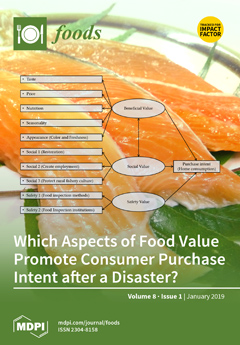Tridax procumbens L. is a medicinal plant and used as a drink to treat bronchial catarrh, diarrhea, dysentery and liver diseases. In this study, we evaluated the potential use of
T. procumbens to treat hyperuricemia, oxidative stress, and bacterial infection. Ethyl acetate extract
[...] Read more.
Tridax procumbens L. is a medicinal plant and used as a drink to treat bronchial catarrh, diarrhea, dysentery and liver diseases. In this study, we evaluated the potential use of
T. procumbens to treat hyperuricemia, oxidative stress, and bacterial infection. Ethyl acetate extract of this plant was separated to different fractions by column chromatography (CC) using chloroform and methanol as eluents and subjected to xanthine oxidase (XO) inhibitory, antioxidant, and antibacterial assays. The results showed that the F
45–47 fraction exhibited the strongest XO inhibitory activity (IC
50 = 133.17 µg/mL), while the F
48–50 fraction possessed maximum antioxidant activity assessed by DPPH (2,2-diphenyl-2-picrylhydrazyl) and ABTS (2,2’-azinobis (3-ethylbenzothiazoline-6-sulfonic acid) assays (IC
50 = 0.51 and 1.04 mg/mL, respectively). In addition, the F
4–5 fraction presented the most effective inhibition on the growth of
Escherichia coli,
Staphylococcus aureus,
Bacillus subtilis, and
Proteus mirabilis. Gas chromatography-mass spectrophotometry (GS-MS) and liquid chromatography-electrospray ionization-mass spectrophotometry (LC-ESI-MS) results revealed that fatty acids, glycerides, and flavonoids were the major compounds of the F
45–47 fraction. Glycerides, triose sugar alcohols, and fatty acids were dominant compounds of the F
48–50 fraction, while sterols were principal components of the F
4–5 fraction. This study indicated that
T. procumbens had potent inhibitory effects on XO inhibitory, antioxidant, and antibacterial activities. These biological activities may be attributed to the presence of fatty acids, flavonoids, and sterols in this plant. It is suggested that
T. procumbens can be utilized as a healthy source to develop beverages and foods to treat antihyperuricemia, oxidative stress, and bacterial infection.
Full article






